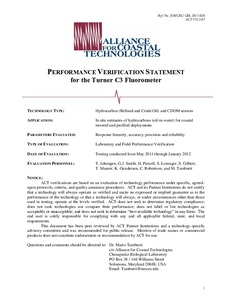| dc.contributor.author | Johengen, T. | |
| dc.contributor.author | Smith, G.J. | |
| dc.contributor.author | Purcell, H. | |
| dc.contributor.author | Loranger, S. | |
| dc.contributor.author | Gilbert, S. | |
| dc.contributor.author | Maurer, T. | |
| dc.contributor.author | Gundersen, K. | |
| dc.contributor.author | Robertson, C. | |
| dc.contributor.author | Tamburri, M. | |
| dc.date.accessioned | 2019-01-21T11:52:01Z | |
| dc.date.available | 2019-01-21T11:52:01Z | |
| dc.date.issued | 2013 | |
| dc.identifier.citation | Johengen, T.; Smith, G.J.; Purcell, H.; Loranger, S.; Gilbert, S.; Maurer, T.; Gundersen, K.; Robertson, C. and Tamburri, M. (2013) Performance Verification Statement for the Turner C3 Fluorometer. Solomons MD, Alliance for Coastal Technologies, 73pp. (ACTVS12-03). DOI: http://dx.doi.org/10.25607/OBP-321 | en_US |
| dc.identifier.other | [UMCES] CBL 2013-020 | |
| dc.identifier.uri | http://hdl.handle.net/11329/764 | |
| dc.identifier.uri | http://dx.doi.org/10.25607/OBP-321 | |
| dc.description.abstract | Instrument performance verification is necessary so that effective existing technologies can
be recognized, and so that promising new technologies can become available to support coastal
science, resource management, and ocean observing systems. The Alliance for Coastal Technologies
(ACT) has therefore completed an evaluation of commercially available in situ hydrocarbon sensors.
This verification included test applications for: (1) controlled laboratory tanks with additions of
various organic, fluorescent compounds, (2) experimental wave tank with additions of two sources of
crude oils with and without dispersants, (3) a moored deployment in Baltimore Harbor, and (4)
hydrocast surveys in the Gulf of Mexico near a leaking oil barge.
In this Verification Statement, we present the performance results of a Turner Designs C3 in
situ fluorometer configured for concurrent measurement of refined fuel, crude oil, and CDOM levels.
The C3 package tested in this verification integrated the Cyclops Refined Fuel Fluorometer (Ex 254
nm, Em 350 nm), the Cyclops Crude Oil Fluorometer (Ex 320, Em 510) and the Cyclops CDOM
fluorometer (Ex 320, Em 470). Response specificity of each individual sensor on the C3 to a range of
organic compounds was evaluated in a series of lab tests. Instrument response with respect to
challenge compound concentration varied with respect to the inherent fluorescence properties of the
challenge compound, as well as, sensor optical configuration. The CDOM sensor detected quinine
sulfate (QS) over a large dynamic range (0-5000 ppb tested) and was insensitive to other organic
compounds tested. The Crude Oil sensor exhibited a similar but dampened response to QS
challenges, as expected based on the optical overlap with the CDOM sensor, but additionally
displayed a weak response to carbazole and #2 Diesel Fuel challenges. The Refined Fuel sensor
exhibited a lower linear dynamic range (0-100 ppb) and distinct sensitivity to challenge compounds,
with sensitivity ranked as Carbazole > #2 Diesel Fuel> NDSA > QS. Instrument responses to
various challenge compounds linearly scaled with standardized EEMs fluorescence intensity for each
compound as estimated to correspond with the instruments emission optics.
The C3 package provided discrimination between crude oil source type and dispersion state
during wave tank trials at the COOGER facility at the Bedford Institute of Oceanography. Response
sensitivity among the three sensors ranked as Refined Fuel > Crude Oil > CDOM. The Crude Oil and
CDOM sensors response baselines were sensitive to daily changes in ambient water CDOM while
the Refined Fuel sensor response was dampened to this ambient background.
Field deployments in Baltimore Harbor and northern Gulf of Mexico were equivocal as all
but three field reference samples were below the limit of detection for total petroleum hydrocarbons
(≤ 25 ppb), yet the output of each of the three sensors was significantly above the baseline response
in deionized water. Instrument response was consistent with environmental background fluorescence
as determined by EEMs analysis for both moored and hydrocast surveys, indicating that ambient
fluorescence properties need to be accounted for to make quantitative hydrocarbon estimates from
these sensors.
During this evaluation, no problems were encountered with the provided software, set-up
functions, or data extraction at any of the test sites. One hundred percent of the data was recovered
from the instrument and no outlier values were observed for any of the laboratory tests, field
deployment tests, or tank exposure tests. Quality assurance (QA) oversight of the verification was
provided by an ACT QA specialist, who conducted technical systems audits and a data quality audit
of the test data We encourage readers to review the entire document for a comprehensive
understanding of instrument performance. | en_US |
| dc.language.iso | en | en_US |
| dc.publisher | Alliance for Coastal Technologies (ACT) | en_US |
| dc.relation.ispartofseries | ACT VS; 12-03 | |
| dc.rights | CC0 1.0 Universal | * |
| dc.rights.uri | http://creativecommons.org/publicdomain/zero/1.0/ | * |
| dc.title | Performance Verification Statement for the Turner C3 Fluorometer | en_US |
| dc.type | Report | en_US |
| dc.description.status | Published | en_US |
| dc.format.pages | 73pp. | en_US |
| dc.description.refereed | Refereed | en_US |
| dc.publisher.place | Solomons, MD | en_US |
| dc.subject.parameterDiscipline | Biogeochemistry | en_US |
| dc.description.currentstatus | Current | en_US |
| dc.description.eov | Ocean Colour | en_US |
| dc.description.bptype | Best Practice | en_US |
| dc.description.bptype | Standard Operating Procedure | en_US |
| obps.contact.contactemail | info@act-us.info | |
| obps.contact.contactemail | Tamburri@umces.edu | |
| obps.resourceurl.publisher | http://www.act-us.info/evaluations.php | en_US |
 Repository of community practices in Ocean Research, Applications and Data/Information Management
Repository of community practices in Ocean Research, Applications and Data/Information Management

